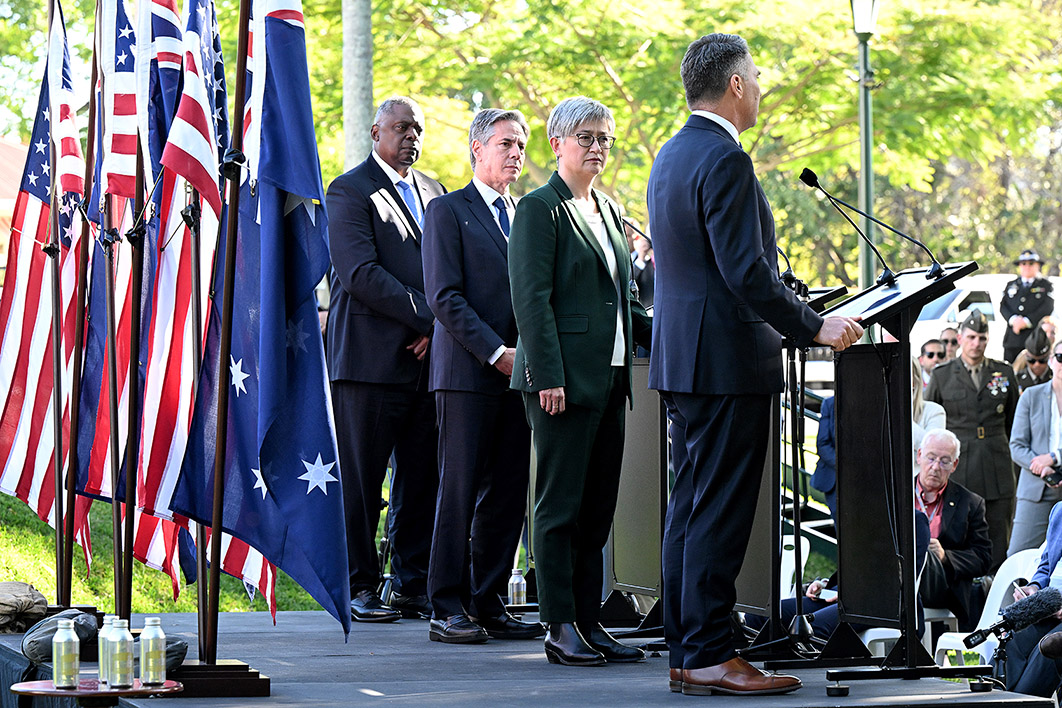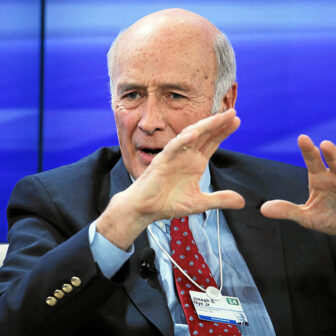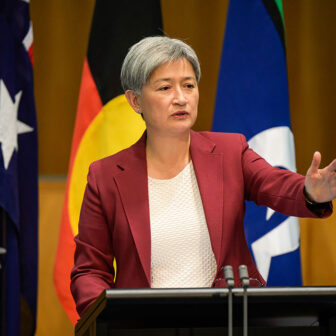When Anthony Albanese hosted Indian prime minister Narendra Modi for what became an ecstatic three-day visit at the end of May, Asia’s other giant seemed at last to be lining up with American allies against China while also offering China-dependent Australia a trade hedge.
US president Joe Biden had rushed back to Washington from the G7 summit in Hiroshima to negotiate a debt-ceiling deal with Congress. Otherwise he would have joined Modi, Albanese and Japan’s prime minister Fumio Kishida in Sydney for a meeting of the Quad, that relatively new grouping seen in American and Australian circles as a way of countering the two Asian countries’ diffidence about lining up against China. (Japan’s diffidence reflects its post-1945 constitution’s bar on non-defensive use of force, India’s its longstanding non-alignment doctrine.)
But what if the Quad instead became a forum for Japan and India to enlist Australia’s help in persuading Washington to give China some space? Just such a proposal is put forward in “Asia’s Future at a Crossroads: A Japanese Strategy for Peace and Sustainable Prosperity,” a paper published in Tokyo at the end of July.
The paper comes not from familiar members of Japan’s left but from Japanese scholars and a South Korean co-author who mostly gained their doctorates in the United States. The two lead authors, Mike Mochizuki and Kuniko Ashizawa, are professors at George Washington University in the American capital.
In essence, the paper argues that Japan should lead a “middle power” effort to lower tensions in Asia. “As part of its middle power diplomacy,” the scholars write, “Japan could also build on the Quad… and take the lead in promoting a ‘middle power coalition’ among Japan, Australia, and India, and thus lead the agenda-setting of the Quad.”
The coalition could then be extended to include other middle powers in the region, including South Korea and the ASEAN countries: “In this process, it would be effective to envision a ‘middle power quad’ by inviting South Korea to join the Japan–Australia–India coalition. By building on its partnerships with middle powers in Asia and in Europe, Japan should vigorously engage China to stabilise bilateral relations as well as to cooperate on pressing transnational challenges.”
The paper’s critique and proposals may upset comfortable assumptions in Washington and Canberra. “Rather [than] being solely dependent on the United States,” it says, “Japan needs a more autonomous foreign policy — what might be called a ‘pro-American, autonomous diplomacy.’” Instead of being “self-righteous” about values-oriented foreign policy, Japan should respect political diversity and promote peaceful coexistence, resisting efforts to divide Asia into a struggle between democracies and autocracies.
This vision is offered as a counterpoint to the concept of the “Indo-Pacific” — a formulation developed by Canberra pundits and adopted by the United States — which “diminishes the importance of continental Asia and suggests a regional orientation designed to counter and even contain China.”
The authors see the National Security Strategy announced by Prime Minister Kishida in December as a “180-degree turnaround” from longstanding Japanese defence policy. It included a doubling of defence spending to 2 per cent of GDP and an arsenal of new Tomahawk cruise missiles designed to strike back at China and North Korea. Commenting on the counterstrike capabilities of the missiles, they argue that “what would only be of tactical use during a military conflict is recklessly justified from the logic of strategic deterrence.”
Rather than treating Australia as Japan’s most important partner in middle-power diplomacy, the authors turn to South Korea: an established democracy and developed economy (one of the world’s ten largest) with per capita income equal to or exceeding Japan’s.
“Both countries [Japan and South Korea] are close allies of the United States; and they both see North Korea’s nuclear and missile programs as acute threats and are concerned about China’s military build-up and coercive behaviour,” says the paper. “But at the same time, they share a deep interest in preventing a military conflict in East Asia that would have devastating consequences for both countries; and they want to maintain close and stable economic relations with China, which is their largest trading partner. In short, both Japan and South Korea desire an Asia that is not divided into two conflicting camps and would prefer a region that is open and inclusive.”
The scholars believe the new version of the Trans-Pacific Partnership — the trade, investment and data pact Australia and Japan pressed ahead with after Donald Trump withdrew the United States — should be opened to simultaneous admission to both China, once it meets its qualifications, and Taiwan.
The paper’s authors aren’t arguing for an unarmed Japan. But they fear that conflict over Taiwan would have a devastating impact on Japan, probably as a result of Chinese attacks on US bases there. They agree that the United States must show it could beat off a Chinese invasion of Taiwan. “Japan can best contribute to this deterrence by denial by improving the resilience and survivability of US and Japanese defence assets in Japan and by strengthening Japan’s own capabilities to defend its own territory, especially its southwest island chain that is close to Taiwan.”
The key point is that the capacity to strike Chinese military targets on the mainland with missiles would not add greatly to deterrence, since China has too many targets and could rain fire back on a more compact Japan.
While the Biden administration has recently emphasised that America’s “One China” policy hasn’t changed, calls by Congress members and former officials to drop the policy, extend diplomatic recognition to Taiwan and defend Taiwan unconditionally are “especially provocative” and have raised the danger of conflict over Taiwan.
Japan’s aim “should be to maintain the conditions for preserving the status quo until the day comes when China and Taiwan can find a peaceful solution to the issue of unification,” the scholars urge, adding: “Moreover, Japan should not base its policies on forecasts of imminent military conflict or Chinese purported deadlines on unification and should not support the drawing of various ‘redlines.’”
The proposals in “Asia’s Future at a Crossroads” are likely to be welcomed by those senior figures in Australia’s foreign affairs and strategic circles — mostly out of government positions now — who criticise an increasingly security-oriented approach to Asia, along with our tightening “interoperability” with US forces and an apparent concurrence in US primacy.
They also chime with the kind of ideas the foreign minister, Penny Wong, was putting forward in opposition, which have been submerged by the unequivocal embrace of the AUKUS agreement on nuclear-powered submarines and advanced technologies.
Some of Kishida’s December proposals are similar to contentious Australian moves by Scott Morrison and now Anthony Albanese. Notable among these are a closer commitment to the defence of Taiwan and general alliance war-fighting capability, and the acquisition of 2000-kilometre-range Tomahawks and other missiles to strike back at China. The difference here is that Australia’s missiles would have to be fired from submarines, ships or aircraft some thousands of kilometres away from Australia.
The key question is: how much influence will “Asia’s Future at a Crossroads” have in Japan? The answer is not much, at least immediately. The paper was published two days before Japan’s defence ministry, the Self-Defence Agency, came out with a new white paper that, as defence minister Yasukazu Hamada said, “explains how we will drastically reinforce our defence capabilities.”
On Taiwan, the white paper doesn’t go as far as Kishida’s Liberal Democratic Party predecessors — Shinzo Abe said a Taiwan conflict would be an “emergency” for Japan and Taro Aso suggested Japan could join Taiwan’s defence — but it strongly supports the “counterstrike” capability in case Japan comes under fire.
Still, the yearning for peace in Japan, ingrained since the wartime US firebombing and atomic attacks on its cities, will act as a political brake on rearmament and assertive power play. Despite the belligerent drift in Chinese security policy since 2012 under Xi Jinping, the notion of an underlying Asian affinity also remains.
That notion last surfaced in 2009 when a splinter of the Liberal Democratic Party called the Democratic Party of Japan, led by former LDP politician Yukio Hatoyama, swept into power, interrupting near-unbroken LDP rule since the end of the Allied occupation in 1952. The foreign policies of the incoming government so concerned Washington that US secretary of state Hillary Clinton handed Japan policy to the Pentagon. (One of the authors of “Asia’s Future at a Crossroads,” Kiyoshi Sugawa, was an adviser in the Democratic Party government.)
Three years later, with the Democratic Party in disarray, the LDP was back under Shinzo Abe, who set about turning Japan into a militarily “normal” state.
Yet the LDP’s Kishida has gone part of the way in the direction proposed in “Asia’s Future at a Crossroads” by rescuing Japan’s relations with Seoul from the plunge under Shinzo Abe over South Korean grievances dating from Japan’s 1910–45 annexation of that country. Helped by South Korea’s election last year of a more conservative president, Yoon Suk Yeol, and stepped-up missile testing and nuclear threats by North Korea’s Kim Jong Un, Kishida has developed a warmer partnership on several fronts, including defence.
In June, he also announced plans to expand staff in Japan’s foreign ministry to 8000 by 2030, a 20 per cent increase on current levels, in order to step up Japan’s engagement with the world, especially Asia, and counter China’s influence. While most reporting focused on China’s 7 per cent increase in defence spending this year, Beijing also said it was spending 12.2 per cent more on its diplomacy.
In Australia, meanwhile, the military brass section still dominates the foreign policy orchestra. The latest formal talks between Australian and US foreign and defence ministers, in Brisbane on 28–29 July, will have pleased China hawks and made critics of the alliance drift grind their teeth. In the background, some 30,000 American, Australian and allied defence personnel were engaged in the biannual Talisman Sabre war games.
Australia will be hosting more US forces, manufacturing missiles for both countries in two years, somehow getting hold of its US nuclear submarines despite problems in the US Congress, and — mentioned only vaguely — becoming more deeply involved in US space warfare capability. Albanese is out to pre-empt any criticism at the upcoming Australian Labor Party national conference in Brisbane.
The growing closeness to Washington has so far earned Labor no evident traction in getting WikiLeaks founder Julian Assange free of US efforts to extradite and charge him under its espionage law.
Some sign of a resurgence in the influence of the Department of Foreign Affairs and Trade came in April, when the government’s Defence Strategic Review recommended that it “be appropriately resourced to lead a nationally determined and strategically directed whole-of-government statecraft effort in the Indo-Pacific.” And glimmers of Foreign Affairs influence were evident when Albanese stressed the importance of diplomacy as well as deterrence and the need for “guardrails” to avoid conflict, and praised Biden for talking to China, at the annual Shangri-la Dialogue in Singapore in early June.
But Foreign Affairs still seems undernourished for a more central role. A departmental spokesperson tells me that “work is under way across agencies to implement the government’s response to the Defence Strategic Review,” but evidence Foreign Affairs is still a supporting act to Defence can be seen in one of its latest budget allocations: $52.7 million over two years from 2023–24 “to provide international policy advice and diplomatic support for the nuclear-powered submarine program.”
The sophisticated debate in Japan and India’s ambivalence about deeper military ties under the Quad (including its late withdrawal from the Talisman Sabre exercise) indicates the department has much work to do in guiding its political masters around this complicated region. And if Donald Trump does return to the White House, the idea of Japan, India and Australia using the Quad to handle America might not be so far-fetched. •




